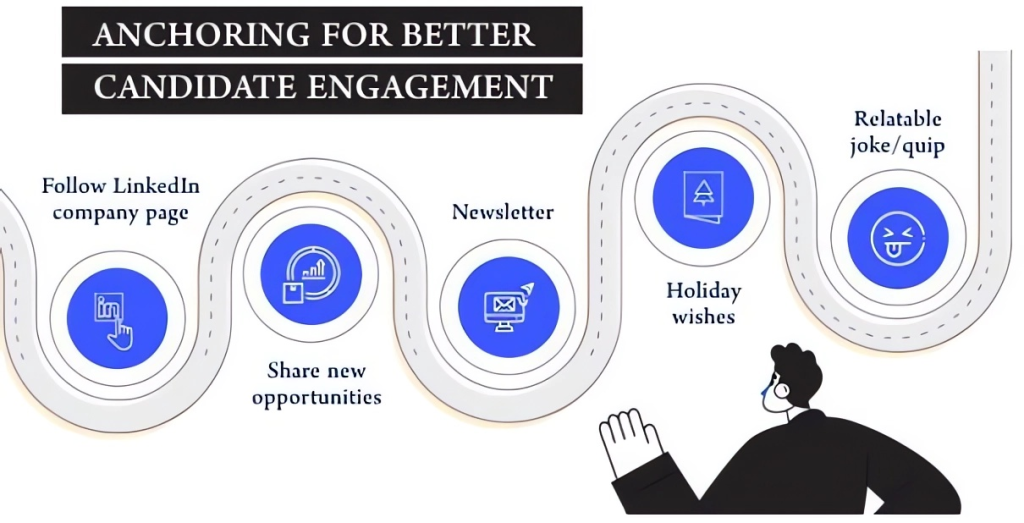Do you remember the high-stakes gambling at a football game between Nicky (Will Smith) and Liyuan (BD Wong) from the movie Focus? In the end, Nicky bets that his friend, Jess, will choose a number on a player’s t-shirt, and that will be the exact number Liyuan will choose too.
And yes, Nicky wins the bet!
It feels crazy at first, but then he goes on and explains how he did it.
Nicky subtly etches the number 55 in Liyuan’s mind using clever clues. For example, hotel room numbers, movie posters, and a song that has ‘Wu’ (number 5 in Chinese). To reinforce it, Nicky makes his friend’s (Farhad) face familiar to Liyuan by putting it on a truck ad and making him seem to honk and shout in the traffic.
Before you know it, Liyuan passes the ball to Jess without even realizing that he’s been manipulated into making that decision.
Thanks to the anchoring technique!
What is the anchoring technique and how does it relate to candidate sourcing?
Anchoring is a subtle technique of influencing someone’s decision-making process by using visual or auditory cues. The goal is to guide their decision toward a desired outcome without them realizing it.
While it is unethical to manipulate people, if used to convey true information, it can help a person make an informed decision.
In NLP (Neuro-linguistic programming), the anchoring technique involves linking an internal response with an external or internal trigger. It enables the response to be readily accessed, sometimes concealed. [Source]
What is its use in talent sourcing?
The technique can be used in talent sourcing by linking a specific stimulus or cue to a particular response or behaviour to create a positive association between the candidate and the company, building a sense of loyalty and engagement.
Then the question arises, how do you create these cues in the right way so they do not have a negative impact and feel subtle, informative, or the best – natural?
Let’s see how!
Let’s consider three scenarios after a Sourcer/recruiter sends outreaches with a job opportunity to a candidate and has completed the cadence:
Scenario 0: The candidate is interested and becomes an applicant. In this scenario, you wouldn’t need any further touchpoints.
Scenario 1: The candidate replies but is not interested at the moment.anony
Scenario 2: The candidate doesn’t reply throughout the cadence, where the sourcer can assume that the candidate is not interested.
As you can see, two scenarios require further candidate engagement: scenarios 1 and 2, where the candidate is not ready for a change but might be in the future. We need to ensure that when a candidate thinks of a job change, they must think of contacting you first.

Let’s see how we can create something subtle yet powerful when this situation occurs.
Consider that you have received a reply stating that the candidate is not interested at the time and needs to be engaged until they convert into an applicant.
Here are five ways for sourcers/recruiters to provide subtle cues for candidates throughout a year:
- Follow LinkedIn company page: Encourage candidates to follow your company’s LinkedIn page. It will keep them up-to-date on any news or updates about your company, and can also give them a sense of the company culture.
- Share new opportunities: When you have a new job opening, reach out to your network and share the opportunity with them. It shows that you value their expertise and may even inspire them to apply for the role.
- Newsletter: Send out a quarterly or monthly newsletter to your network with updates on your company, industry news, and any relevant job opportunities. It keeps you top-of-mind and can help you build relationships with potential candidates.
- Holiday wishes: Send out holiday wishes to your network during major holidays such as Thanksgiving or Christmas. It can be a simple message that shows you care about your network and want to maintain a positive relationship with them.
- Relatable joke/quip: Consider sending out a relatable joke now and then. It can be a simple way to show your personality and connect with your network on a personal level. Just make sure the joke is appropriate and doesn’t offend anyone!
Conclusion
In conclusion, anchoring emerges as a pivotal strategy in transforming candidate engagement into a dynamic and enduring process. Recognizing the significance of first impressions, and cultivating positive anchors sets the stage for lasting connections.
Building trust through intentional rapport-building anchors is key to establishing a foundation of credibility and mutual understanding.
Moreover, the positive impact of anchoring extends beyond initial interactions, significantly contributing to the enhancement of the overall candidate experience. By viewing anchoring as a catalyst for long-term relationship building, organizations can lay the groundwork for sustained connections and future opportunities, solidifying their commitment to fostering meaningful and lasting relationships with candidates.
